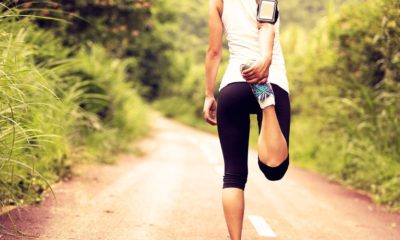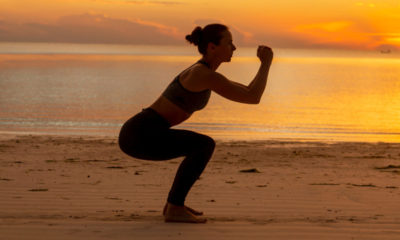Fitness
5 Ways To Get Kenyan Inspired Endurance
Kenyans have dominated the distance running world for more than 30 years. Here’s how to use their stamina-building secrets in your own training, no matter what your sport is.
1. Start off slow
Scott Douglas, author of The Little Red Book of Running, spent months living and training with Kenyans and discovered they didn’t wear fancy pace-setting watches to dictate their speed. Instead, Kenyans start every run at a super-slow pace, but within a few short minutes of being warmed up they kick it up a gear, going from stumbling to sprinting.
Keeping your warm-up short and specific is a lesson well learned because research in the Journal of Applied Physiology found that short, low-intensity warm-ups enhance athletic performance while long drawn out warm-ups can sabotage it.
This is a contentious issue in sports as each coach has his own ideas about this practice, but the above study found the shorter warm-up resulted in significantly less muscle fatigue and a peak power output that was 6% higher. Rather save your breath for the moment it counts: winning.
2. Elastic power
Pulling back an elastic band and shooting it off creates two types of energy: the strength to pull it back and the release of elastic energy when it flies off your thumb. Turns out, Kenyans have more of this elastic energy in their legs.
Research in the European Journal of Applied Physiology compared elite Kenyan distance runners to average Caucasian runners and found the Kenyans were able to hop with a shorter contact time on the ground, yet got more height. This is much the same way a kangaroo gets from A to B, via elastic energy.
You can use this trick in your day-to-day sports because research in Medicine in Science and Sports found that when people dropped from a raised platform then jumped as high as they could they were able to jump far higher than they could from a stationary standing start.
You may not be allowed to carry a step ladder with you on the basketball court, but doing a small jump before your big jump will help store elastic energy that you can release with all its fury on your opponent.
3. Going barefoot
Dr Joe Vigil, the assistant running coach to the United States Olympic distance running team, estimates the average Kenyan teenager clocks up more than 250,000km of barefoot running before they’ve strapped on a pair of flashy new trainers.
That means their running form is hard-wired for light-footed efficiency. Of course, come race day they’ll strap on shoes, because, well, nobody is foolish enough to risk a first-place pay day for the sake of a sharp pebble.
Regardless of your sport, running forms the cornerstone of good cardiovascular fitness and going barefoot can offer some advantages. Researchers at Northumbria University, UK, found when runners, who normally wore shoes, switched to barefoot running they used less oxygen and improved their running economy by 3%.
The ‘labcoats’ say this enhanced efficiency helped the runners cover longer distances with less effort because it encouraged them to have shorter stride lengths, but spend less time in contact with the ground. Take home message: you tend to float, rather than plod along.
What’s more, running without the foot-tech can also help strengthen the muscles in your feet and lower legs. So if your running niggles have put you on your physio’s Christmas card list then a switch to barefoot may help shore up any weaknesses because it encourages you to land on your forefoot rather than your heel, lowering the impact force and lessening your risk of injury.
That said, it isn’t a complete injury elixir and can cause problems if you dive into it with reckless abandon because you’ll probably lack the initial foot strength. Rather ease yourself into it by barefoot running 10% of your usual weekly running load and gradually increase it.
Unfortunately, Terra Firma has turned from a green jungle to a concrete one so start on grass and wear barefoot running shoes to insulate your pedicure against any sharp objects.
4. Eating right
Research in the International Journal of Sport Nutrition and Exercise Metabolism found Kenyan energy staples were bread, boiled rice, poached potatoes, boiled porridge, cabbage and kidney beans.
Meat (primarily beef) was eaten just four times a week in fairly small amounts of about 100g. The take-home message was that the world’s best endurance athletes make sure 75% of their daily calories come from vegetable carbs and they eat the same amounts every day. Without knowing it, they adhered to the current sport science guidelines of eating 9g of carbs per 1kg of body weight per day. Stick with that and you’ll furnish yourself with more stamina than an Everest Sherpa.
5. Aiming high
Most Kenyans train at about 8,000 feet above sea level, but regardless of your sport you can still harness the benefits of altitude training, even if you’re not gallivanting up and down mountain sides.
In fact, research in High Altitude Medicine and Biology found training in high altitude environments can improve VO2max by 13% (a benchmark for aerobic fitness) and can boost long to medium distance running times (lasting more than 20 minutes).
So if you can’t get to the mountain then bring the mountain to you by training at a hypoxic training centre. This is the kind of Kenyan huff and puff that’ll get your chest across the finish line before the next guy’s.
Find fitness advice and more in every issue of TRAIN FOR HER.






















